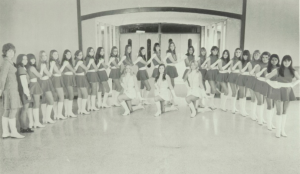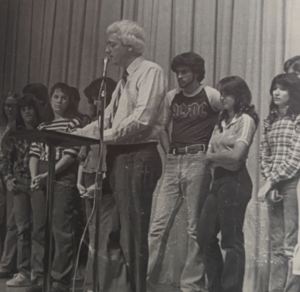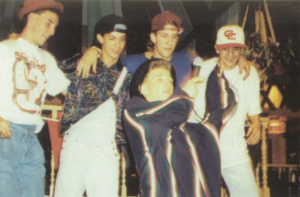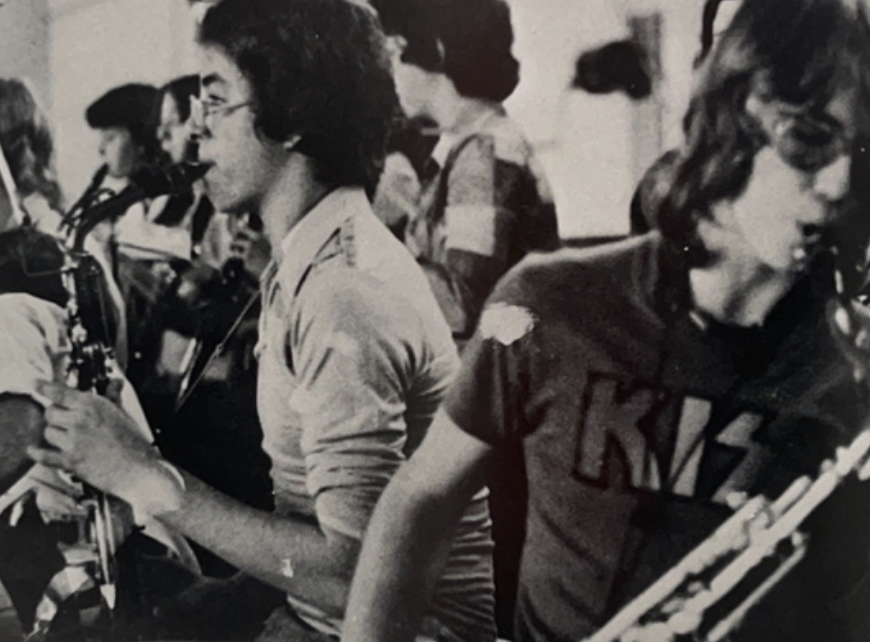Rock music’s evolution: Its influence on the world and Coppell
A Coppell Band student wears the t-shirt of popular hard rock band KISS in the 1977-78 Coppell High School yearbook. Rock music is considered one of the most influential genres of music in the world and has impacted fashion, trends, slang and roles of women and minorities in the music industry.
May 19, 2023
Lingering in the aisles of Josey Records, my dad, Tom Dwyer, and I read the names on the divider between the CDs, labeled “Classic Rock.” My dad pulls out various albums as he describes their releases and how he either had them on vinyl or CD when he was younger.
We both stare in confusion when we see 60s folk rock band The Mamas & The Papas CDs resting above the 90s goth metal band Marilyn Manson. Finding it hard to believe those two bands belong in the same genre, we continue walking down the aisle. I try to think of which would belong in the rock section, but my mind enters a dead end when I realize they both do.
Rock is said to be one of the greatest genres of music of all time. The genre dominated the late 20th century and was the face of the music industry for decades. As the years went on, rock music changed, but the love for it stayed the same. Though new genres emerged and fell, rock music stayed in control of the music scene.
The change of the decades saw the change of rock music, but even today, the impacts of rock music can still be felt throughout the world.
The 1950s
There’s no doubt that rock-n-roll has had different definitions over the last 70 years. Historians have many timelines for the origin of rock music, ranging from the 1920s to 1950s. Billboard pinned the first real rock-n-roll star to be Chuck Berry in 1953.
In the 1950s, Black artists were the blueprint for rock music. The genre was more R&B/Soul than rock music in later decades. Each later decade took on more subgenres, and the subgenre of the 1950s is known as rockabilly.
The ‘50s and ‘60s had many Black rock artists, but rising white artists such as Elvis Presley, Jerry Lee Lewis, Bill Haley & His Comets, Buddy Holly and The Everly Brothers typically saw more fame in the public eye than. Still, the history and origin of the rock music we all know and love unquestionably lies in the hands of the brilliant Black singers of the ‘50s. Black artists like Little Richard, Ray Charles, Chuck Berry and James Brown are some of the most important rock stars of the 50s.
Elvis Presley was first noticed when he recorded his first song on the radio: “That’s All Right,” at a recording studio that was typically popular among Black artists. He was offered the gig to play at the Louisiana Hayride in October 1954.
Presley gained attention when people realized he was white because of his voice, which was inspired by Black artists. Though Presley took opportunities away from Black singers trying to make it into the music industry, he was also helpful for them, as Presley’s credit to Black singers started to shine light on the talent of their music. Black singer Little Richard said that when the music industry locked the door to Black artists, Presley opened the door for them through his frequent covers of songs written by Black singers. Still, Presley’s popularity created controversy within the American household.
Presley was accused of being a rebellious influence on young people. Many parents believed he should’ve been in jail for his scandalous dancing on stage. Upcoming artists began to notice the popularity of Presley and used his controversial dance moves and singing to spark the beginning of controversy in rock music.
Though they may not have been as credited for their impact, the singers of the 1950s gave later rock artists the foundation to step out of their comfort zone and try new things. Over time, more credit has been given to the Black singers of the 50s and 60s. The debt to African-American musicians and their inspiration for other artists continues to be acknowledged today.
The 1960s
The 1960s was the time rock music changed. The ‘60s marked the meteoric rise of hall-of-fame rock bands: many still define the genre today, most notably The Beatles, the Rolling Stones, Pink Floyd, The Mamas & The Papas, The Doors and The Beach Boys. The subgenre of the 1960s became more psychedelic and folk with elements of music from the Middle East and India.
The ‘60s was not solely a significant time for rock, but also a significant part of history. The 1960s saw The Civil Rights Movement, Hippie Movement and the Vietnam War. The Beatles’ John Lennon used his fame to shine a light on his activism. Lennon and his wife, Yoko Ono, were active in protests against war and promoted a movement of counterculture in the 1960s.
Because the Vietnam War was the first televised war, people were beginning to see what life in battle was like. The resulting counterculture movement soon began to promote universal equality, women’s rights, civil rights, environmentalism and the gay liberation movement.
The goal of the “American Dream” began to fade away from the minds of the youth. In the ‘50s and prior, women were housewives who cared for the children, cooked and cleaned the home. Men were expected to find a steady job and be the provider for the family. During the various movements in the ‘60s, women began wanting to work or not get married.
The new era of counterculture allowed changes in fashion. Women and men began to grow their hair and wear it down. They would wear traditional African, Indian and Middle Eastern styles of clothes. The wearing of natural hair (especially by African-Americans), dresses and skirts beginning to end above the knees and denim (especially bell bottom jeans) became popular during the 1960s.
The 60s also marked the beginning of drugs’ influence on rock . Many iconic stars of the 1960s died from drug-related deaths, such as Jim Morrison, Janis Joplin, Brian Jones, Zeke Zettner, Dickie Pride and Jimi Hendrix. The effects of drug addiction changed the relationship of multiple bands and obstructed many’s success.
A significant event in music history, and one of the biggest music festivals to ever take place, was Woodstock in 1969, with nearly 500,000 attendees. The goal of Woodstock was for people to escape into music and spread a message of unity and peace; however the festival organizers hadn’t set everything up in time, so the festival was overcrowded. More than 5,000 medical incidents were reported to officials, 800 of which were drug-related.
The 1970s
The 1970s arguably had the greatest influence on rock music. With deaths and band breakups of psychedelic rock artists such as the Beatles, The Doors, Jimi Hendrix and Janis Joplin, hard rock bands formed and took more control over the genre. Music equipment gave artists more than four tracks to work with, and music became much more experimental than it was capable of in the ‘60s. The ‘70s saw the emergence of different kinds of rock. Both soft and hard rock became popular.
In this decade, more iconic bands and solo artists emerged in the rock industry such as Queen, AC/DC, the Eagles, Fleetwood Mac, Journey, Kiss, Van Halen, David Bowie, U2, Led Zeppelin and Aerosmith. The 70s is the decade that takes up most of the albums in Rolling Stone’s “The 500 Greatest Albums of All Time,” with 36.6% of the albums in the 2003 edition made in the 1970s, 37.2% of the 2012 edition and 31.4% of the 2020 edition.
Though rock music was still popular, different genres like disco emerged. So many rock fans hated the rise of disco music that, famously, in 1979, Disco Demolition Night took place. Over 5,000 fans stormed the field at Chicago’s Comiskey Park in a riot following the burning and explosion of disco records.

By 1973, androgynous glam rock fashion had become mainstream for young British people of both sexes. People would wear Western shirts, velvet sports coats, Royal Stewart tartan, red or blue shawl collar tuxedo jackets, frilly shirts, high necked Nehru jackets, synthetic fabrics, silk scarfs, shawl collar sweaters, satin shirts with oversized collars, drainpipe trousers and platform shoes. Unisex men’s and women’s outfits often came together in matching sets and popular muted colors like cream, burgundy, brown and orange.
During the 1970s and 80s, band T-shirts became popular amongst teens and young adults. Fans were already making their own merchandise, and musicians realized they could release their own concert tees as a new revenue stream. Famous band T-shirts became a common sight amongst students at Coppell at this time.
The mid-1960s saw the popularization of a low-heeled style of women’s fashion boots called go-go boots. The boots were typically worn by go-go girls who gained popularity for their dancing, called go-go dancing, and were typically employed to entertain crowds at rock nightclubs in Los Angeles In the 1970s, the Coppell drill team would wear go-go boots with their uniforms.
The 1980s
In the 1980s, rock took a turn. The 1980s saw the rise of electronic dance music and new wave, also known as Modern Rock. Though rock was still significant in the music industry, pop began to take a hold of the music industry. Synthetic drums, VOX and auto-tuning, drone chords and better amps gained popularity in the 1980s.
The subgenre of the 1980s was glam rock, after the influence of glam rock fashion from the ‘70s. Glam rock music was typically performed by musicians wearing vibrant and shocking costumes, makeup and hairstyles. Most notably, David Bowie began to blur the lines between what was defined as men’s clothes and women’s clothes.

The influence of drugs was still significant in the 1980s. Iconic bands formed during the 80s include Guns N’ Roses, Metallica, Bon Jovi, Red Hot Chili Peppers, Mötley Crüe and R.E.M. This decade also introduced CDs which changed the game for the entire music industry, not just rock.
Though rock was at its peak in the 1980s, other genres were gaining traction amongst youth as well, and rock became a genre more popular amongst adults. Most teens began listening to pop music and artists such as Duran Duran, Michael Jackson, Madonna, Tears for Fears and Whitney Houston. The ‘80s is also the time when music videos began to be commonplace with the advancement of video technology.
A straight-edge lifestyle gained popularity at the beginning of the 1980s, influenced by the band Minor Threat. Hardcore punks came to be in this decade, with a straight-edge attitude of refraining from substance abuse and turning to sobriety and abstinence.
In the 1980s, heavy metal bands frequently favored a powerful visual image. This included wearing leather or denim jackets and jeans, spikes or studs, and long hair for some bands. Glam metal was strongly influenced by a visual image.
The 1990s
The ‘90s: the ending to a millennium. Nirvana, Green Day, Radiohead, Sublime, Foo Fighters, Weezer, Blur, Blink-182 and Smashing Pumpkins smashed onto the scene. Gone were the hippie and calming ideas of rock. The 90s introduced grunge, alternative rock and the rise of industrial rock and punk. Also returning? The use of drugs. The ‘90s again became a time when artists struggled with abusing drugs.

Grunge’s rise to fame in the 1990s ushered in a punk-influenced look of its own, with people donning ripped jeans, worn-out sneakers, flannel shirts, backward baseball caps, and long hair in opposition to the time-honored, sharp-dressed aesthetic of the hugely marketed pop music scene.
The decade saw an increase in hip-hop’s popularity and the continuation of the genre’s golden age. Aside from rap, contemporary R&B and reggae, hip-hop continued its popularity throughout the decade. In the late 1980s and 90s, hip-hop blended with jazz, soul, funk to create popular fusions like new jack swing, neo-soul, hip-hop soul and g-funk.
Then, there was the day the 90s died: Woodstock 1999. While Woodstock 1969’s goal was to be peaceful and happy, Woodstock ‘99 was quite literally the opposite. The festival was overcrowded, water was limited, covered with garbage, security was not at their posts, multiple sexual assault charges, tons of riots and fires, 1,200 medical facility admissions on-site, 44 arrests, and even three deaths. Though there have been attempts to revive the festival, the requests have been turned down.
The 2000s to present
It was the start of a new millennium, yet not the start of a new era for rock music. The 2000s had music similar to the 1990s with a garage rock, post-punk and new wave revival. Though the music industry became saturated with pop and hip-hop artists, rock was still very popular. Fall Out Boy, Avril Lavigne, Evanescence, The Killers and Arctic Monkeys came into the spotlight during the new millennium.
Towards the end of the 2000s, the popularity of rock music went down for the first time since the 1950s. The early 2010s is considered the prime for pop music. The reason for the decline in rock music is likely due to many iconic rock stars retiring or bands disbanding.
Though there are fewer and fewer purely rock bands/artists now, many people continue to listen to rock music from the past and reflect on the importance of rock music in the music industry today. Rock music has had significant impacts on society and shaped many cultures around the globe. The legacy of rock stars and their impact on others remains in the music today and inspiration is reflected through artists across all genres.
Follow Ainsley (@ainsleydwyer) and @CHSCampusNews on Twitter










